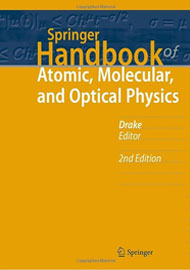
This is the second edition of Springer’s comprehensive Handbook of Atomic, Molecular, and Optical Physics, developed from a first edition published in 2006. In a new foreword, Daniel Kleppner describes some of the intervening advances that warranted a new edition; similar sentiments are expressed in a new preface by the editor, Gordon Drake.
This edition comprises almost a hundred chapters covering over 1400 pages, divided into seven sections. The most sizeable of these are on mathematical methods, atoms, scattering theory, scattering experiments and quantum optics. The others, one on molecules and the other a very selective section on applications, are the shortest by far. There is sound coverage of groundwork theory, especially in atomic and quantum physics and traditional laser physics, and many well-known names are featured among the authors.
Attempting to encompass the full scope of this title’s remit is an invidious enterprise, and the result is perhaps inevitably patchy. Nonetheless, for a second edition with such an ambitious title, I do feel that the intended readership has been let down in several respects. The worst offense, to my eyes, is the astonishing failure of numerous chapters to show any sign at all of updating. The editor identifies four chapters on fundamental theory where, quite rightly, no revisions were considered necessary. But I found numerous other chapters (at least seven more, not on theory) that still contain no reference to any literature later than 2004—all predating the first edition.
Some of the other chapters also look quite dated, showing few signs of comprehensive updates. This really does a disservice to those authors who clearly have supplied meticulously updated content. So, too, does the editorial failure of the publisher to correct the obvious mistake in the header of one chapter: “Gas Phase Ionic Reactions Abstract” (also appearing as such in the list of contents).
The coverage of molecular physics is disappointing. Excepting the two chapters on atmospheric physics and on astrophysics, the treatment of topics in this area focuses almost entirely on very small molecules in the gas phase. I found nothing on 2D molecular materials such as graphene, or on modern large-scale molecular dynamics simulations of the condensed phase. The treatment of optical methods for cooling and trapping also omits the condensed phase, where major applications are already deployed in techniques such as optical tweezers. Structured light, such as optical vortices, is yet another important topic that is missing.
I also feel that the selection of topics for the six chapters in the section on applications is unrepresentative, with only the one on global change addressing any impact on everyday lives or products. Optical physics in the condensed phase is one of the most outstanding areas of commercial application; this handbook would never give readers that impression.
In summary, I find with regret that the value of this new edition has been compromised by a confinement to the essential structure of the previous edition. I also recognize that in compiling any volume of work on this scale, it is statistically likely that the editor encountered authors who promised chapters on some of the missing topics, but who ultimately failed to deliver. Having found myself in a similar position at times in the past, I genuinely sympathize.
Review by David L. Andrews, Optica Fellow and professor, University of East Anglia, UK
The opinions expressed in the book review section are those of the reviewer and do not necessarily reflect those of OPN or its publisher, Optica (formerly OSA).
